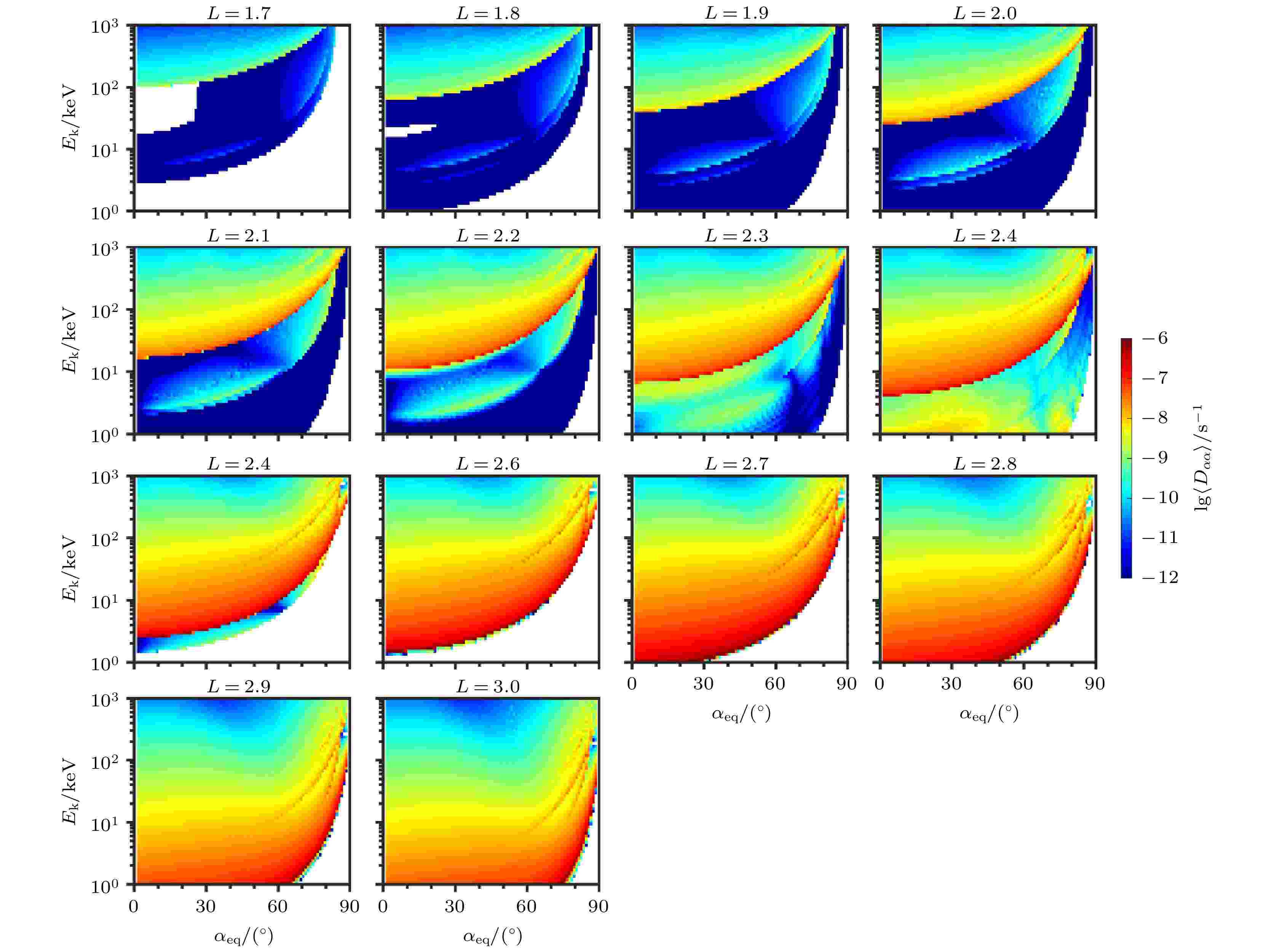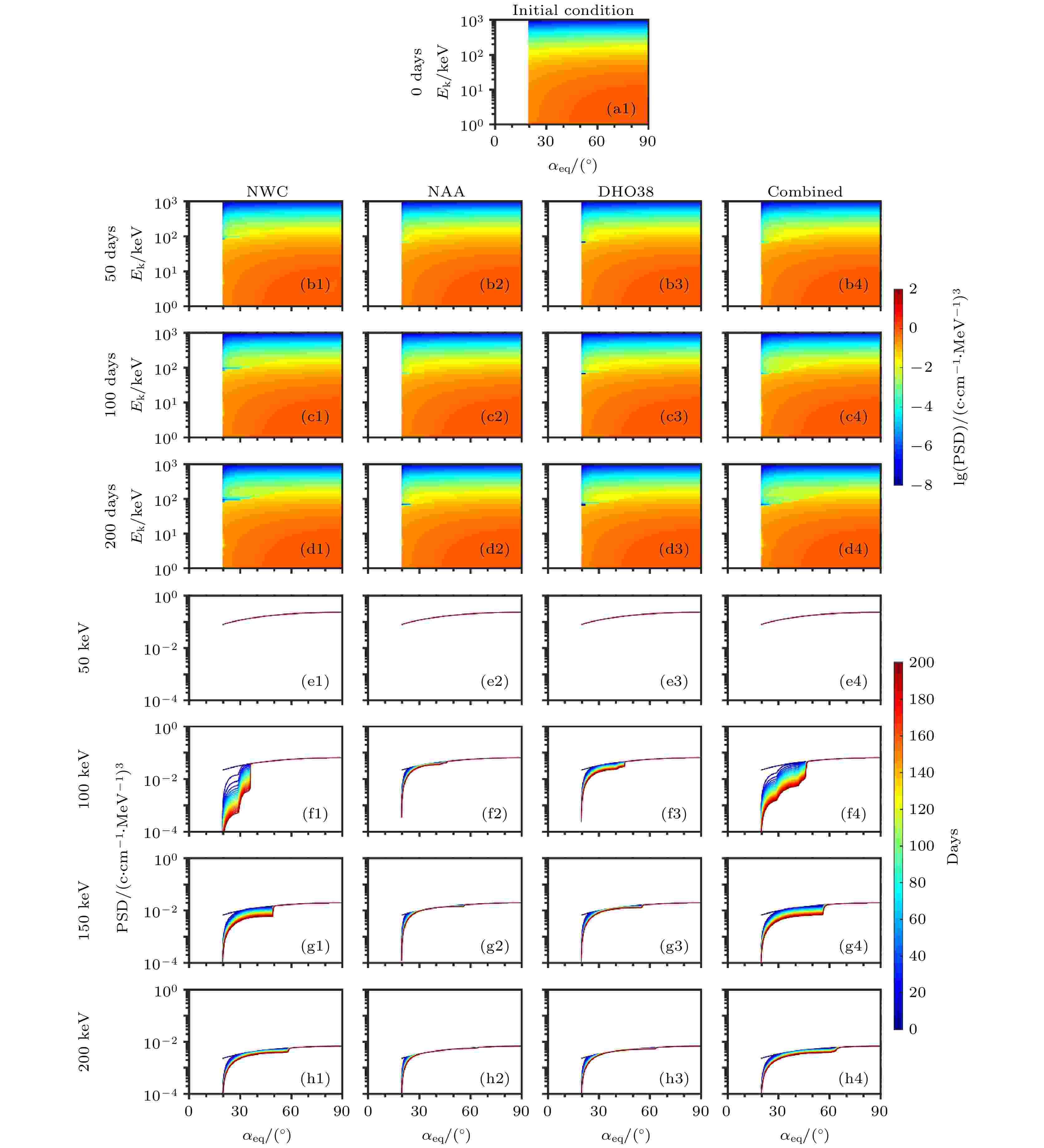全文HTML
--> --> -->通常认为外辐射带的变化较为剧烈[1-3]而内辐射带相对稳定. 近期的研究结果表明, 内辐射带的高能电子会在磁暴期间因为注入而增强, 然后在平静时期逐渐下降[4,5]. 宇宙射线反照中子衰变[6-9]、自然激发的哨声波(如等离子体层嘶声[10,11]、雷电产生的哨声波[12-14]等)、磁声波[15-17]以及地面台站发射的甚低频(very low frequency, VLF)信号[18-20]都能对内辐射带及槽区的高能电子通量产生影响. 其中, 地面人工台站发射的10—30 kHz的VLF信号主要用于对潜通信, 可以在地球-低电离层波导中进行远距离的传播, 通过地面VLF接收机[21,22]接收的VLF信号, 可用于反演电离层的变化特征[23-25]. VLF信号在沿地球-低电离层波导传播时, 会有小部分穿透电离层, 泄露进入内磁层, 与电子发生回旋共振, 使其扩散进入损失锥, 从而沉降到大气中[26-33]. 近几十年来, 国内外的专家****在地面人工台站VLF信号影响辐射带电子动态变化这一方向做了很多研究. 如直接观测到了与台站发射波形ON/OFF调制周期一致的粒子沉降周期[34-36]; 通过DEMETER卫星的观测数据[37,38]和射线追踪模拟[39], 得出了NWC台站发射的信号会引起内磁层中大于100 keV电子沉降的结论; 通过准线性理论定量计算了VLF信号在与辐射带电子发生回旋共振时, 改变不同的参数对投掷角扩散系数大小的影响[40,41]. 这些研究大多基于理论计算和射线追踪得到VLF台站信号的波模, 并没有使用实际观测结果. 通过范艾伦探测双星中的A星的数据, 文献[18]得到了10—60 kHz的VLF台站信号在磁层中的统计模型, 并计算了VLF台站信号与嘶声共同散射时, 内辐射带及槽区的电子的生命周期将下降1—2个数量级; 文献[42]统计了VLF台站信号在磁层中的全球分布. 文献[19]根据文献[42]的结果计算了VLF台站信号、嘶声和库仑碰撞联合散射时对高能电子的散射效应, 结果表明VLF台站信号可以使内磁层中500 keV电子的生命周期, 在200 d内下降一个数量级, 使槽区40 keV电子的生命周期在100 d内下降一个数量级.
在分析VLF台站信号对高能电子的散射效应时, 之前的研究大多使用投掷角扩散系数来计算电子损失时间尺度[18,33], 这一方法的优点是步骤简单、计算量小, 缺点是无法具体分析不同投掷角电子在损失时的详细演化过程. 为了系统、细致分析各个VLF台站信号对不同投掷角高能电子的散射效应, 本文在文献[42]统计模型基础上, 使用准线性理论计算NWC, NAA和DHO38三个台站发射的VLF信号对高能电子的弹跳平均投掷角扩散系数, 并将其代入到一维Fokker-Planck方程求解高能电子在全投掷角范围的演化过程. 第2节介绍使用的理论模型, 第3节介绍模拟结果, 第4节总结.
2.1.投掷角扩散率的计算
统计结果[42]表明, 在内辐射带和槽区中, 50%以上的VLF台站信号能量来自于NWC, NAA, DHO38这三个台站, 因此本文主要分析这三个台站的VLF信号对内辐射带和槽区高能电子的散射效应. 之前的研究表明, 在L < 1.7, VLF波主要以非导管的方式传播(在赤道附近, 波的传播方向与磁力线之间夹角约为60o—70o); 而在更高的L-shell, VLF波主要以导管的方式传播(即波沿磁力线近似于准平行传播)[18,29,38,39]. 根据这些结论, 本文假设在L < 1.7的VLF台站信号全部为非导管传播; 在1.7 ≤ L < 2.5的VLF台站信号, 25%的波是非导管传播, 75%为导管传播; 在L ≥ 2.5的VLF台站信号为导管传播[18]. 本文使用文献[42]对VLF台站信号的统计结果作为内辐射带和槽区VLF台站信号分布的主要依据. 因为文献[42]在计算VLF台站信号的波幅时假设在所有的L-shell, 波均以导管的方式传播(即波传播角θ = 0°), 本文首先采用文献[43]的等离子体层密度模型和偶极子磁场模型, 将文献[42]中VLF台站信号的磁场功率谱密度转换为电场功率谱密度[44]. 然后再假设非导管波的传播角为θ = 65°, 导管波的传播角为θ = 0° [18], 将VLF台站信号的电场功率谱密度转换为对应的磁场功率谱密度[44]. 最后使用新的磁场功率谱密度计算VLF台站信号的波幅, 这样计算的结果使用了VLF台站信号在空间中的实际传播特性, 与实际情况更加接近. 三个VLF台站信号的波幅随L-shell的分布关系如图1所示. 这三个VLF台站的发射频率、功率、地理位置、及L-shell分布范围如表1所列. 图 1 计算得到的三个台站的波幅
图 1 计算得到的三个台站的波幅Figure1. Calculated wave amplitudes from three VLF transmitters.
| 台站 | 频率/kHz | 功率/kW | 经纬度 | L-shell | 磁层中波 幅范围/L |
| NWC | 19.8 | 1000 | 21.8°S 114.2°E | 1.42 | 1.5—2.2 |
| NAA | 24.0 | 1000 | 44.6°N 67.3°W | 2.74 | 1.7—3.0 |
| DHO38 | 23.4 | 300 | 53.1°N 7.6°E | 2.38 | 1.7—2.9 |
表1选取计算的台站信息
Table1.The information of the three selected VLF transmitters.
根据上面计算的VLF台站信号波幅, 使用FDC程序[45] (full diffusion code)计算了VLF台站信号引起的电子弹跳平均投掷角扩散系数














2
2.2.一维Fokker-Planck扩散方程
为了详细分析VLF台站信号对不同投掷角电子的散射效应, 本文将计算得到的弹跳平均投掷角扩散系数应用于求解一维Fokker-Planck扩散方程[47], 模拟电子相空间密度(phase space density, PSD)的演化过程. 一维Fokker-Planck扩散方程为










3.1.扩散系数计算结果
图2为NWC台站信号在L = 1.5—2.2引起的弹跳平均电子投掷角扩散系数. 图中横坐标为电子的赤道投掷角, 纵坐标为电子能量, 颜色表示电子投掷角扩散系数的大小. 以L = 1.5为例, 扩散系数分为两部分, 其中一部分集中在能量为400—1000 keV, 投掷角为0—57o的范围, 是电子与VLF信号发生回旋共振导致的. 可以发现, 随着能量的增加, 发生回旋共振的投掷角范围也在增加, 而扩散系数峰值在最小共振能量处, 最小共振能量随着投掷角的增加而增大. 另一部分投掷角扩散系数是电子与VLF台站信号发生朗道共振导致的. 相对于回旋共振, 朗道共振导致的扩散系数要弱1—2个数量级. 在L = 1.6—2.2, 投掷角扩散系数的分布特征与L = 1.5的相似, 最小回旋共振能量随着L-shell的增加而降低, 这是因为电子回旋频率随着L-shell的增加而降低[18,19]. 在L = 1.6和L = 1.7的波幅相近, 但L = 1.7处回旋共振(低投掷角)的扩散系数明显增大, 而朗道共振(高投掷角)的扩散系数相对减弱, 这是由于在L = 1.7处导管传播的VLF台站信号比例(75%)高于L = 1.6 (0%), 这些结果说明当波幅相近时, 导管传播的VLF台站信号对电子的散射效应要明显强于非导管传播的VLF台站信号. 在L = 1.7和L = 1.8处, 投掷角扩散系数最大, 约为
 图 2 NWC台站信号在L = 1.5—2.2导致的电子弹跳平均投掷角扩散系数
图 2 NWC台站信号在L = 1.5—2.2导致的电子弹跳平均投掷角扩散系数


Figure2. The color-code bounce-averaged pitch angle diffusion coefficients



NAA台站信号和DHO38台站信号引起的电子弹跳平均投掷角扩散系数如图3和图4所示. 图的格式与图2相同, 投掷角扩散系数的特征也与图2相似. 由于NAA和DHO38这两个台站的发射频率相近, 在相同的L-shell, 两个台站信号散射的电子能级范围和投掷角范围几乎一致, 随着L-shell的增加, NAA和DHO38台站信号能散射更小能量的电子, 如在L = 2.6处, 扩散系数的峰值在几keV. 随着投掷角的增加, 扩散系数的峰值移向更高能量的电子. 在更高的L-shell, 扩散系数的峰值下移至几百eV能量. 由图1可以看出, NAA和DHO38台站的波幅在L = 2.2—2.7较大, 这些L-shell相应的的扩散系数也较大, 最大值可达到约

 图 3 NAA台站信号在L = 1.7—3.0导致的电子弹跳平均投掷角扩散系数. 格式同图2
图 3 NAA台站信号在L = 1.7—3.0导致的电子弹跳平均投掷角扩散系数. 格式同图2Figure3. Same as in Fig. 2 except for VLF transmitter signals from NAA at L = 1.7–3.0.
 图 4 DHO38台站信号在L = 1.7?2.9导致的电子弹跳平均投掷角扩散系数. 格式同图2
图 4 DHO38台站信号在L = 1.7?2.9导致的电子弹跳平均投掷角扩散系数. 格式同图2Figure4. Same as in figure 2 except for VLF transmitter signals from DHO38 at L = 1.7?2.9.
2
3.2.散射效应模拟结果
为了进一步研究VLF台站信号对内辐射带和槽区不同投掷角高能电子的散射效应, 计算VLF台站信号导致的电子弹跳平均投掷角扩散系数后, 将其用于求解一维Fokker-Planck扩散方程.图5是L = 1.8处, 在VLF台站信号的作用下, 电子PSD随时间演化过程的模拟结果. 初始的电子PSD投掷角分布如图5(a1)所示, 图5(b1)—图5(d4)为采用不同VLF台站信号(从左至右分别为NWC, NAA, DHO38台站单独作用和三个台站信号的联合作用), 高能电子PSD演化的分布图(从上至下分别为50, 100和200 d). 图中横坐标为电子赤道投掷角, 纵坐标为电子能量, 颜色表示电子PSD的大小. 图中空白区域为损失锥(电子赤道投掷角小于20o的范围). 从图5可以看出, 在L = 1.8处, NWC台站信号对电子的散射作用最强, 可以使90—120 keV、赤道投掷角小于40o的电子PSD在200 d内减少至少一个数量级; NAA和DHO38台站信号只对80 keV左右、损失锥附近的电子有散射作用. 这与上一节计算的投掷角扩散系数分布是对应的. 三个VLF台站信号联合散射时, 电子PSD下降范围与NWC台站信号单独作用时大体一致. 表明在低L-shell, NWC台站信号对高能电子的散射起主导作用.
 图 5 在L = 1.8处, 不同VLF台站信号对电子散射效果的模拟, 从左至右分别为NWC, NAA, DHO38台站信号单独散射和三个台站信号联合散射 (a1)?(d4)不同模拟时间的电子相空间密度分布二维图, 颜色表示电子相空间密度的大小; (e1)?(h4)指定能级电子的相空间密度随时间演化的过程图, 线条颜色表示不同的时间
图 5 在L = 1.8处, 不同VLF台站信号对电子散射效果的模拟, 从左至右分别为NWC, NAA, DHO38台站信号单独散射和三个台站信号联合散射 (a1)?(d4)不同模拟时间的电子相空间密度分布二维图, 颜色表示电子相空间密度的大小; (e1)?(h4)指定能级电子的相空间密度随时间演化的过程图, 线条颜色表示不同的时间Figure5. (a1)?(d4) Two dimensional distributions of color-code electron phase space density (PSD) as a function of equatorial pitch angle





图5(e1)—图5(h4)给出了在不同VLF台站信号的作用下, 指定能级电子PSD随时间的演化. 图中横坐标是电子赤道投掷角, 纵坐标是电子PSD, 线条颜色代表不同时间. 可以看出, 对于100 keV电子, NWC台站信号可以使低投掷角(< 40o)电子PSD在200 d内减少一个数量级左右, 并且电子越接近损失锥, 损失效果越明显. 但NAA和DHO38台站信号对电子无明显散射效应. 所有VLF台站信号对于高投掷角(< 80o)电子均无明显散射效应.
在L = 2.2和L = 2.6处, VLF台站信号作用下, 电子PSD随时间演化的模拟结果如图6和图7所示, 图的格式与图5相同. 对比不同L的模拟结果可以发现, 发生损失的电子能量随L-shell的增加而减小. 在L = 2.2 (图6)处, NWC台站信号只对约 20 keV电子有微弱的散射作用, 而NAA台站信号和DHO38台站信号对电子的散射作用较强, 主要散射10—20 keV、投掷角小于50o的电子, 且DHO38台站信号对电子的散射作用更强. 如NAA台站信号可以使20 keV、投掷角小于50o的电子PSD在200 d内减少5倍, DHO38台站信号能使之减少一个数量级. 在L = 2.6(图7)处, NAA, DHO38台站信号对几keV、投掷角小于60o的电子有较强的散射作用, NAA台站信号的散射作用更强. 如DHO38台站信号能使5 keV、投掷角小于60o的电子PSD在200 d内减少5倍, 而NAA台站信号能使之减少一个数量级. 当这两个VLF台站的信号联合散射时, 电子损失加快. 由图6和图7可以看出, 在2.2 ≤ L ≤ 2.7, 主要是NAA和DHO38台站的信号引起电子的损失, 且电子损失的速度与VLF台站信号幅值的大小成正比.
 图 6 在L = 2.2处, 不同VLF台站信号对电子的散射效果模拟, 格式同图5
图 6 在L = 2.2处, 不同VLF台站信号对电子的散射效果模拟, 格式同图5Figure6. Same as in Fig. 5 except for at L = 2.2.
 图 7 在L = 2.6处, 不同VLF台站信号对电子的散射效果模拟. 格式同图5
图 7 在L = 2.6处, 不同VLF台站信号对电子的散射效果模拟. 格式同图5Figure7. Same as in Fig. 5 except for at L = 2.6.
1)在低L-shell (L ≤ 1.8), NWC台站对电子的散射作用相对较强, 主要散射能量为100 keV左右、投掷角小于60o的电子. 随着L-shell降低, 主要散射的电子能量升高, 从L = 1.8到L = 1.5, 主要散射的电子能级从90—120 keV升高到550—650 keV.
2)在高L-shell (2.2 ≤ L ≤ 2.7), 主要是NAA和DHO38台站信号对电子起散射作用, 主要散射几十keV、投掷角小于70o的电子. 从L = 2.2到L = 2.7, 主要散射的电子能级从10—20 keV下降到几keV.
3) VLF台站信号对高投掷角(> 80o)电子均无显著散射作用.
